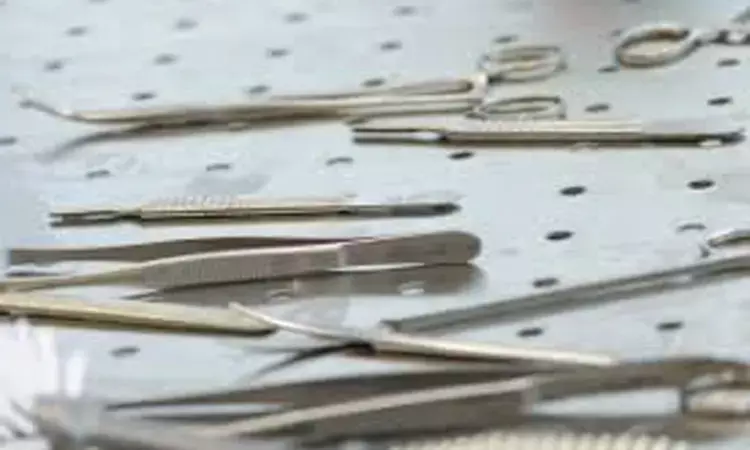- Home
- Medical news & Guidelines
- Anesthesiology
- Cardiology and CTVS
- Critical Care
- Dentistry
- Dermatology
- Diabetes and Endocrinology
- ENT
- Gastroenterology
- Medicine
- Nephrology
- Neurology
- Obstretics-Gynaecology
- Oncology
- Ophthalmology
- Orthopaedics
- Pediatrics-Neonatology
- Psychiatry
- Pulmonology
- Radiology
- Surgery
- Urology
- Laboratory Medicine
- Diet
- Nursing
- Paramedical
- Physiotherapy
- Health news
- Fact Check
- Bone Health Fact Check
- Brain Health Fact Check
- Cancer Related Fact Check
- Child Care Fact Check
- Dental and oral health fact check
- Diabetes and metabolic health fact check
- Diet and Nutrition Fact Check
- Eye and ENT Care Fact Check
- Fitness fact check
- Gut health fact check
- Heart health fact check
- Kidney health fact check
- Medical education fact check
- Men's health fact check
- Respiratory fact check
- Skin and hair care fact check
- Vaccine and Immunization fact check
- Women's health fact check
- AYUSH
- State News
- Andaman and Nicobar Islands
- Andhra Pradesh
- Arunachal Pradesh
- Assam
- Bihar
- Chandigarh
- Chattisgarh
- Dadra and Nagar Haveli
- Daman and Diu
- Delhi
- Goa
- Gujarat
- Haryana
- Himachal Pradesh
- Jammu & Kashmir
- Jharkhand
- Karnataka
- Kerala
- Ladakh
- Lakshadweep
- Madhya Pradesh
- Maharashtra
- Manipur
- Meghalaya
- Mizoram
- Nagaland
- Odisha
- Puducherry
- Punjab
- Rajasthan
- Sikkim
- Tamil Nadu
- Telangana
- Tripura
- Uttar Pradesh
- Uttrakhand
- West Bengal
- Medical Education
- Industry
PET-based optical imaging detects cancer cells after radical prostatectomy

Reston, VA--A new intraoperative imaging technique, Cerenkov luminescence imaging (CLI), can accurately assess surgical margins during radical prostatectomy, according to a first-in-human research published in the October issue of the Journal of Nuclear Medicine.German researchers used PET-based optical imaging technique to confirm the presence of cancer cells after prostate cancer surgery,
The feasibility study showed that 68Ga-PSMA CLI can image the entire excised prostate specimen's surface to detect prostate cancer tissue at the resection margin.
Radical prostatectomy is one of the primary treatment options for men with localized prostate cancer. The goal of a radical prostatectomy is to completely resect the prostate without positive surgical margins. Incomplete removal of the cancer tissue during radical prostatectomy is often associated with poorer patient outcomes, including increased likelihood of recurrence and prostate cancer-related mortality.
Prostate-specific membrane antigen (PSMA) ligand positron emission tomography (PET) has emerged as an accurate tool to detect prostate cancer both in primary staging and at time of biochemical recurrence. As PET imaging agents also emit optical photons via a phenomenon called Cerenkov luminescence, researchers sought to evaluate the feasibility and diagnostic accuracy of CLI in detecting prostate cancer.
"Intraoperative radioguidance with CLI may help surgeons in the detection of extracapsular extension, positive surgical margins and lymph node metastases with the aim of increasing surgical precision," stated Christopher Darr, PhD, resident at the Department of Urology of the University Medical Center Essen in Essen, Germany. "The intraoperative use of CLI would allow the examination of the entire prostate surface and provide the surgeon with real-time feedback on the resection margins."
The single-center study included 10 patients with high-risk primary prostate cancer. 68Ga-PSMA PET scans were performed followed by radical prostatectomy and intraoperative CLI of the excised prostate. CLI images were analyzed postoperatively to determine regions of interest based on signal intensity, and tumor-to-background ratios were calculated. CLI tumor margin assessment was performed by analyzing elevated signals at the surface of the intact prostate images. To determine accuracy, tumor margin status as detected by CLI was compared to postoperative histopathology.
Tumor cells were successfully detected on the incised prostate CLI images and confirmed by histopathology. Three patients had positive surgical margins, and in two of the patients, elevated signal levels enabled correct identification on CLI. Overall, 25 out of 35 CLI regions of interest proved to visualize tumor signaling according to standard histopathology.
Boris A. Hadaschik, PhD, director of the Clinic for Urology of the University Medical Center Essen, added, "Radical prostatectomy could achieve significantly higher accuracy and oncological safety, especially in patients with high-risk prostate cancer, through the intraoperative use of radioligands that specifically detect prostate cancer cells. In the future, a targeted resection of lymph node metastases could also be performed in this way. This new imaging combines urologists and nuclear medicine specialists in the local treatment of patients with prostate cancer."
The authors of "Intraoperative 68Gallium-PSMA Cerenkov Luminescence Imaging for Surgical Margins in Radical Prostatectomy - A Feasibility Study" include Christopher Darr, Nina N. Harke, Jan Philipp Radtke, Leubet Yirga, Claudia Kesch and Boris A. Hadaschik, Department of Urology, University Hospital Essen, Essen, Germany; Maarten R. Grootendorst, Clinical Research, Lightpoint Medical Ltd., Chesham, United Kingdom; Wolfgang P. Fendler, Peter Fragoso Costa, Christopher Rischpler, Christine Praus, Ken Herrmann and Ina Binse; Department of Nuclear Medicine, University Hospital Essen, Essen, Germany; Johannes Haubold, Institute of Diagnostics and Radiology, University Hospital Essen, Essen, Germany; and Henning Reis and Thomas Hager, Institute of Pathology, University of Duisburg-Essen, Essen, Germany.
This study was made available online in February 2020 ahead of final publication in print in October 2020.
http://jnm.snmjournals.org/content/61/10/1500
Hina Zahid Joined Medical Dialogue in 2017 with a passion to work as a Reporter. She coordinates with various national and international journals and association and covers all the stories related to Medical guidelines, Medical Journals, rare medical surgeries as well as all the updates in the medical field. Email: editorial@medicaldialogues.in. Contact no. 011-43720751
Dr Kamal Kant Kohli-MBBS, DTCD- a chest specialist with more than 30 years of practice and a flair for writing clinical articles, Dr Kamal Kant Kohli joined Medical Dialogues as a Chief Editor of Medical News. Besides writing articles, as an editor, he proofreads and verifies all the medical content published on Medical Dialogues including those coming from journals, studies,medical conferences,guidelines etc. Email: drkohli@medicaldialogues.in. Contact no. 011-43720751


